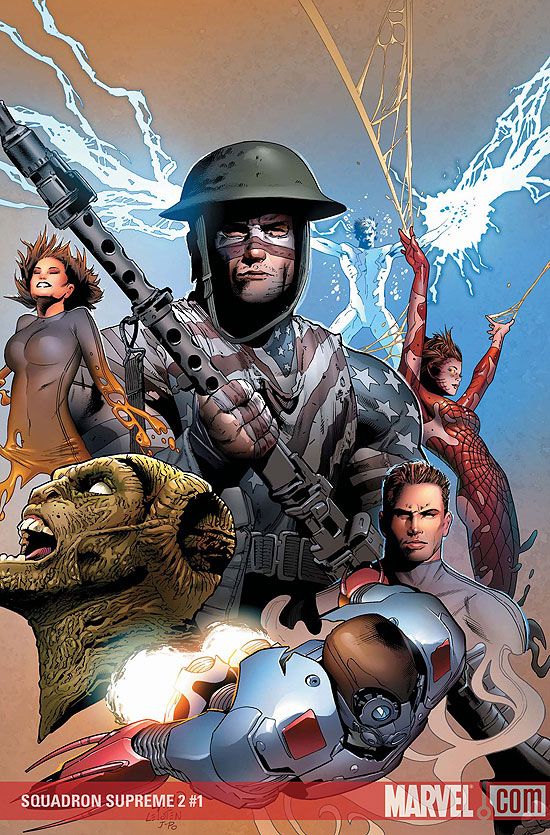This series has had an interesting genesis, to say the least. The Squadron Supreme began, decades ago, as a joke, a kind of "What if the Avengers fought the Justice League of America?" Each member of the Squadron Sinister (as they were originally called, before going through various duplications, and alternate versions, and revamps) reflected one member of the JLA, with Hyperion as Superman, Nighthawk as Batman, etc. You know the story, I'm sure. You probably also know that those one-note DC pastiches eventually ended up with a pretty impressive twelve-issue series written by the late Mark Gruenwald. In many ways, Gruenwald's "Squadron Supreme" series was a transition from the relevant and socially conscious stories of the 1970s to the darkly cynical stories of the 1980s. Neither Gruenwald nor anyone else was able to do much of interest with the characters after that, so when J. Michael Straczynski rebooted the series as a Marvel Max book a few years ago, he had a lot on his side: a general fondness for Gruenwald's series in the back of readers' minds and the freedom to take part of Gruenwald's premise -- super-heroes in the "real world" -- and exploit it in his own way. Straczynski's "Supreme Power" moved slowly, probably too slowly, but it was an interesting attempt at reviving the characters to reflect a new era. Unfortunately, the series kind of drifted off and became a non-Max comic, and then a bunch of mini-series, and then climaxed in a shockingly unspectacular crossover with the Ultimate universe in the "Ultimate Power" series.
I'm going into so much background here because not only is it relevant to the first issue of this new "Squadron Supreme 2" comic, but also because my sense is that whatever goodwill readers once had toward the Squadron Supreme concept has been squandered over recent years, and I want to assure readers that this new series might just be the thing to get the concept back on track. "Squadron Supreme 2" #1 turned out to be a pretty good comic book, and it's one I might have easily overlooked if not for my boundless curiosity about all corners of the superhero world.
Howard Chaykin, writer -- but sadly not artist -- of this limited series, takes some bold steps with the first issue. I don't know if this was all part of Straczynski's original plan, or if some editor mandated this new approach, but what Chaykin does is set this issue five years after "Ultimate Power." Five years is an incredibly long time in the world of a comic book, where characters often stay youthful for decades, and it served here to provide a clean break from what has come before. This "Squadron Supreme 2" book has a completely different status quo -- Hyperion and Nighthawk don't even appear in the first issue. Basically, the star of the book is Nick Fury -- the Sam Jackson/Ultimate universe version, who ended up in the custody of the Squadron at the end of "Ultimate Power." And in the five years that have passed, the Squadron Supreme has fallen completely out of favor on Earth and Nick Fury, although a stranger from an alternate dimension, has risen to power. His sidekick here is Emil Burbank, the Lex Luthor analogue, and former member/nemesis of Squadron Supreme. It's all very convoluted in terms of backstory, but issue #1 is clean and straightforward. It's Nick Fury and Emil Burbank involving themselves in some apparent astronaut shenanigans, while a couple of strange "heroes" make their first appearance.
And it's in the appearance of these strange heroes that we get a sense of where Chaykin is headed with this series. The first hero to appear has strange spider-like powers. The second is draped in the American flag. (On the cover to issue #1, though not yet appearing in the issue, is someone wearing a suit of armor -- perhaps one made from iron.) You can see where this is going, right? Just as the Squadron were originally JLA pastiches, we now get pastiches of the popular Marvel characters -- Spider-Man, Captain America, Iron Man -- appearing in the Squadron Supreme universe. The story doesn't ham it up, and the narrative isn't interrupted by characters winking and laughing with the reader, but this series is clearly designed to play with the Marvel hero archetypes in relation to the DC archetypes of the Squadron. Or maybe not, because the Squadron is barely found within this issue. Maybe Chaykin's new direction is about these strange Marvel analogues replacing the Squadron as the new heroes of Earth. Maybe it's all a meta-commentary on the supremacy of Marvel.
There's plenty to enjoy about "Squadron Supreme 2" #1 without thinking about all of these layers of meaning. It's a story about government conspiracies and strange superhumans. And it's got more than its fair share of Nick Fury, which is never a bad thing. If you felt like Straczynski's version of the Squadron stumbled and then finally collapsed in the lead-up to "Ultimate Power," as I did, I think you'll be pleasantly surprised by what Chaykin's doing here. He's revitalized it, but not in the way I expected.

